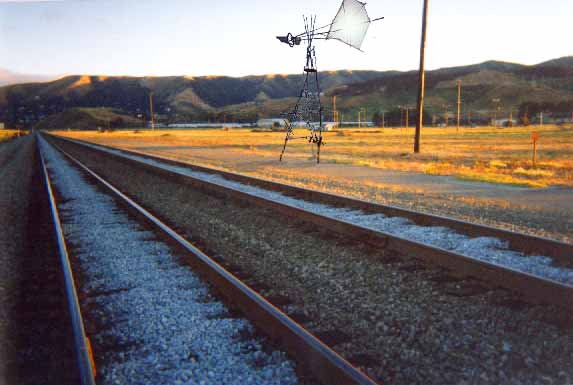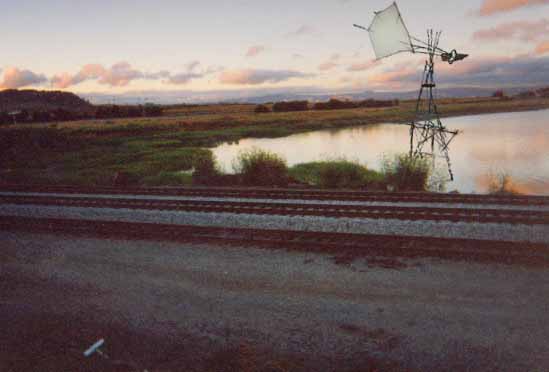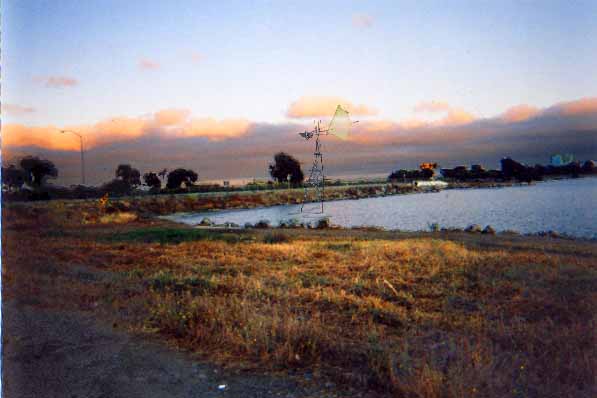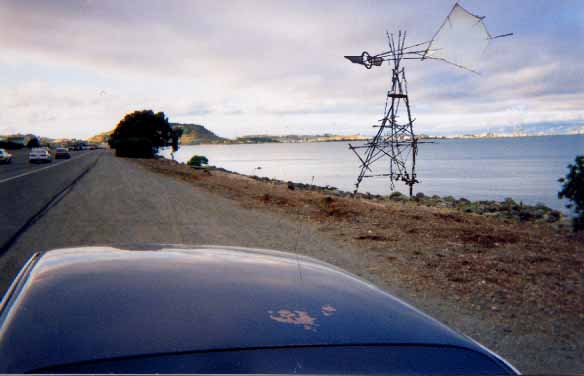
SECESSION GALLERY
HIGH SPEED ART
PROPOSAL FOR
FOUR WINDMILLS
I'm proposing to set up four thirty-foot high windmills that will be visible from Caltrain and/or Highway 101. The windmills would be made from bamboo, sewn muslin and bicycle wheels. They would be positioned near or in the lagoon that drains into the Bay near Candlestick Point.


Three of the
windmills would be positioned in water, close to shore. These
windmills would be anchored by cast concrete weights, with bamboo
running through them.
I have made bamboo
windmills at Tire Beach on the San Francisco Bay and at Burning Man.
They respond to the natural speed of the wind ~ by spinning at
varying rates, turning to face each gust, and by swaying in response
to the slightest change of wind speed or direction. The windmills
have drama, illustrating the conflict between the relative stability
of the ground to the unceasing motion of the wind. They relate the
earth to the sky, and make weather visible on a close-to-human scale.
Travelers moving at "artificial" speeds will be able to observe
"natural" speeds. They provide an alternative frame of reference for
observers.

I have had two experiences in nature that help to illustrate the function of the windmills.
Once, I was
cross-country skiing on the edge of a steep mountain meadow. I was
standing under a pine tree, laden with fresh powder. From across the
meadow, a towering miniature tornado of snow meandered toward me. It
was maybe twenty or thirty feet tall; weather, but close to human
scale. As it came nearer, I felt increasingly in awe of its power. I
held my ground under the pine. When it came to where I was, it dumped
all the fresh snow from the tree's boughs onto my head, and all
around me.

Another time, when I
was on a dry lake bed in the desert with a friend, we chased a
powerful dust devil on our mountain bikes. We caught it, and entered
the vortex, circling in the same direction as it was circling. It was
effortless riding, exciting, but not blustery. We kept pace with the
swirling dust and bits of litter, traveling across the desert floor.
We then attempted reversing directions; circling in the opposite
direction to the wind. It was hellish, we were fighting against a
brutal dust storm.

In both of these
experiences, I encountered nature on a close-to-human scale. Standing
before one of my windmills is a similar (if less dramatic)
experience. The windmill's swaying and bobbing illustrates and
exaggerates the movement of the air masses. The turning of the blades
demonstrates the power of a force that is usually invisible to
us.
As we travel in cars
or trains, we see nature as though it is frozen in time. We move
through the landscape too quickly to see the changing of colors, the
movement of trees or the clouds'; endless dance. The windmill acts as
an anchor, hugging the ground, entering the sky, responding to the
restless movement of the air. A commuter would see how the air is
moving relative to the ground, even in the short amount of time
available as s/he whizzes past at a speed unimaginable even two
hundred years ago.

It has always seemed
to me that the best way to gage how fast one is moving and where s/he
is moving to is to use a different frame of reference.
Larnie Fox
7/31/98